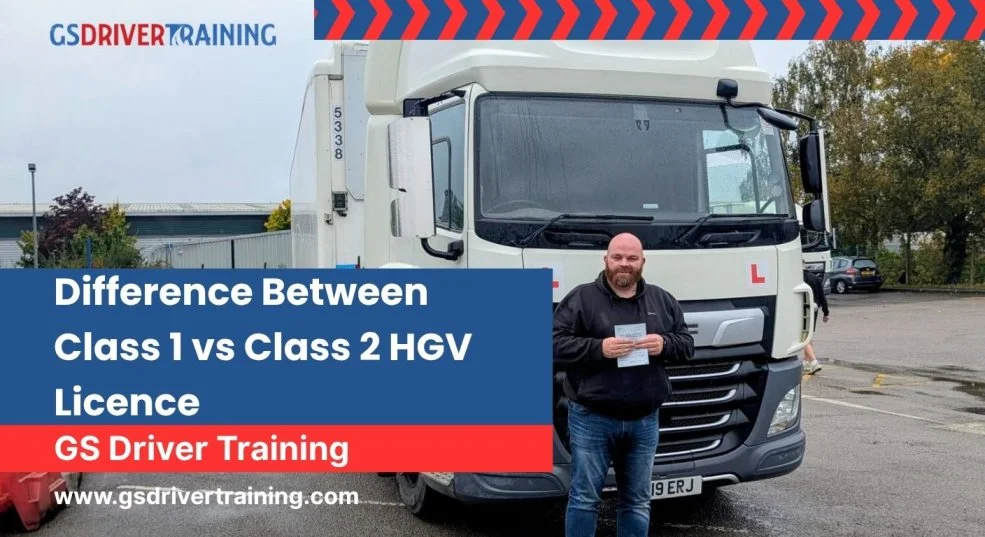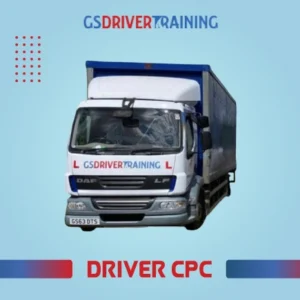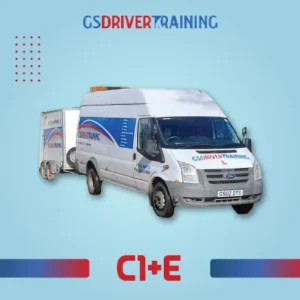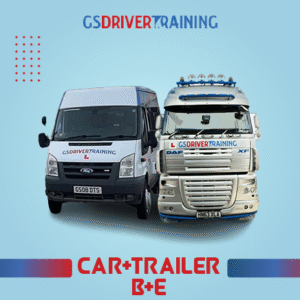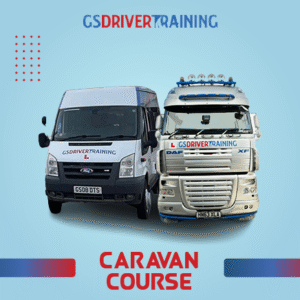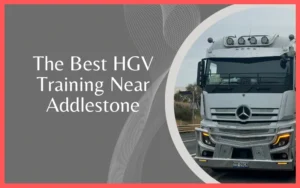Class 1 vs Class 2 HGV Licence: What’s the Difference?
If you’re thinking about becoming a professional HGV driver, one of the first questions you’ll come across is: Whats the difference between a Class 1 and Class 2 HGV licence?
These two licence types define the kinds of heavy goods vehicles you’re legally allowed to drive and can shape the direction of your driving career. Both are valuable qualifications, but they serve different purposes depending on the type of vehicle and journey you plan to take on.
In this article, we’ll explain the difference between Class 1 and Class 2 HGV licences, the training and tests involved, and the kind of jobs and salaries you can expect with each one.
What Is an HGV Licence?
An HGV (Heavy Goods Vehicle) licence allows you to drive vehicles over 3.5 tonnes for commercial purposes. You’ll often hear the term LGV (Large Goods Vehicle) used as well — but don’t be confused.
HGV licences are split into different categories depending on vehicle size, weight, and structure, and the two most common are Class 1 (Category C+E) and Class 2 (Category C).
What Is a Class 2 (Category C) HGV Licence?
A Class 2 HGV licence, also called a Category C licence, allows you to drive rigid-body vehicles that weigh over 7.5 tonnes. “Rigid” means that the cab and the trailer are permanently attached as one solid unit.
These vehicles are typically used for:
- Local or regional deliveries
- Waste collection
- Construction transport
- Retail and supermarket distribution
Key Features of Class 2 Vehicles:
- Structure: Rigid body (cab and load are part of one frame).
- Weight limit: Up to 32 tonnes.
- Axles: Usually two or more.
- Manoeuvrability: Easier to drive and park compared to articulated lorries.
- Driving style: Suited for shorter, urban routes.
Class 2 vehicles are ideal for drivers who prefer local or daytime work, as they typically involve shorter routes and regular schedules.
Training & Requirements for a Class 2 Licence
Before you can apply for a Class 2 HGV licence, you’ll need to meet a few basic requirements:
- Be at least 18 years old.
- Hold a full Category B (car) licence.
- Pass a medical exam to confirm you’re fit to drive heavy vehicles.
- Apply for a provisional Category C licence from the DVLA.
- Pass the theory and hazard perception tests.
- Complete a Driver CPC (Certificate of Professional Competence) if you plan to drive professionally.
Once these are complete, you’ll undertake practical HGV training with a qualified instructor. This usually takes around 5–7 days, depending on your previous experience. Training focuses on:
- Vehicle control and safety checks
- Reversing and turning techniques
- Road awareness and hazard perception
- Efficient driving for fuel and time management
After training, you’ll take your practical test, which includes an on-road assessment and vehicle safety questions.
What Is a Class 1 (Category C+E) HGV Licence?
A Class 1 HGV licence, also known as a Category C+E licence, allows you to drive articulated lorries — large vehicles with a detachable trailer.
These are the massive trucks you often see on motorways transporting goods between cities or across Europe. Because they can carry more weight and travel longer distances, a Class 1 licence opens up more job opportunities and higher pay.
These vehicles are typically used for:
- Long-distance haulage across the UK and Europe
- Container and freight transport
- Supermarket and warehouse distribution
- Fuel, goods, or bulk material deliveries
- Logistics and import/export operations
Key Features of Class 1 Vehicles:
- Structure: Tractor unit with a detachable trailer
- Weight limit: Up to 44 tonnes
- Flexibility: Trailers can be swapped to carry different cargo types
- Driving style: Suited for long-distance or international transport
- Common uses: Haulage, logistics, container transport, and freight
Driving articulated lorries requires more skill due to their size, turning radius, and the complexity of coupling and uncoupling the trailer.
Training & Requirements for a Class 1 Licence
To get a Class 1 (C+E) licence, you must already hold (or directly train for) a Class 2 (Category C) licence.
Since November 2021, you can now go straight to a Class 1 licence without passing a Class 2 test first — a change introduced by the DVSA to tackle the UK’s driver shortage and simplify the process.
Here’s how the process works:
- Hold a full Category B licence.
- Pass a medical exam.
- Apply for a provisional Category C+E licence.
- Pass the HGV theory and hazard perception tests.
- Complete professional Class 1 training.
- Obtain the Driver CPC qualification.
- Pass your practical test in an articulated lorry.
Class 1 training focuses on:
- Coupling and uncoupling trailers
- Reversing articulated vehicles
- Handling long and heavy loads
- Motorway and long-distance driving
Training usually takes 7–10 days, and costs range from £1,500 to £2,500, depending on your provider and whether you’re upgrading from Class 2.
Key Differences Between Class 1 and Class 2 HGV Licences
Here’s a simple side-by-side comparison:
|
Feature |
Class 2 (Category C) |
Class 1 (Category C+E) |
| Vehicle Type | Rigid lorry | Articulated lorry |
| Weight Limit | Up to 32 tonnes | Up to 44 tonnes |
| Vehicle Structure | Cab and load fixed together | Cab with detachable trailer |
| Manoeuvrability | Easier for city driving | Requires more skill to reverse/turn |
| Ideal For | Local or regional deliveries | Long-distance or international haulage |
| Training Level | Entry-level HGV licence | Advanced HGV licence |
| Average Salary | £28,000 – £35,000 per year | £35,000 – £50,000+ per year |
| Typical Employers | Retailers, councils, local logistics | Haulage firms, freight, container transport |
Career Opportunities
With a Class 2 Licence:
A Class 2 licence qualifies you for jobs such as:
- Supermarket delivery driver
- Construction or skip lorry driver
- Refuse collection driver
- Local freight or parcel delivery
These jobs are perfect if you prefer set hours and shorter routes.
With a Class 1 Licence:
A Class 1 licence unlocks opportunities like:
- Long-haul truck driver
- International freight driver
- Container or tanker operator
- Distribution centre transporter
You’ll likely cover longer distances, spend more time on the road, and earn a higher wage.
From Class 2 to Class 1: Career Progression
Many UK drivers begin with a Class 2 licence to gain experience before upgrading to Class 1. This path helps you build confidence handling large vehicles before tackling the challenges of articulated lorries.
Upgrading from Class 2 to Class 1 typically involves:
- Additional training on articulated vehicles
- Learning trailer coupling/uncoupling
- Passing the Category C+E practical test
Some training schools, like GS Driver Training, offer combined or fast-track courses that take you directly from car licence to Class 1.
How Much Does HGV Training Cost in the UK?
While prices vary between schools and regions, here’s an approximate guide:
|
Licence Type |
Duration |
Average Cost (UK) |
| Class 2 (Category C) | 5–7 days | £1,000 – £1,500 |
| Class 1 (Category C+E)** (Upgrade) | 5–7 days | £1,200 – £2,000 |
| Direct Access (Car → Class 1) | 7–10 days | £2,000 – £2,500 |
Many training providers offer finance options, Train Now, Pay Later schemes, or employer-sponsored programmes to make it easier to start your training journey.
Which HGV Licence Is Right for You?
- Choose Class 2 if you want to:
- Start quickly in the industry
- Do local or city-based deliveries
- Have a predictable schedule and be home most nights
- Choose Class 1 if you want to:
- Earn more and progress in your career
- Drive longer distances or work internationally
- Operate larger vehicles and trailers
No matter which licence you choose, the UK logistics sector offers stable work, excellent benefits, and plenty of opportunities for advancement.
Ready to Get Your Class 1 or Class 2 Licence?
GS Driver Training offers expert courses for both Class 1 and Class 2 licences. With flexible schedules, modern vehicles, and experienced instructors, we’ll guide you every step of the way-helping you gain the skills and confidence to start your commercial driving career.
Final Thoughts
Both Class 1 and Class 2 HGV licences are valuable qualifications that can lead to a rewarding and well-paid career in logistics.
If you’re new to professional driving, start with Class 2 to build your skills. If you’re ready for the challenge — and higher earnings — a Class 1 licence will take your career even further.
Whichever path you choose, make sure to train with an approved, experienced HGV training provider. Quality training not only helps you pass your tests but also ensures you become a safe, confident, and professional driver on UK roads.

